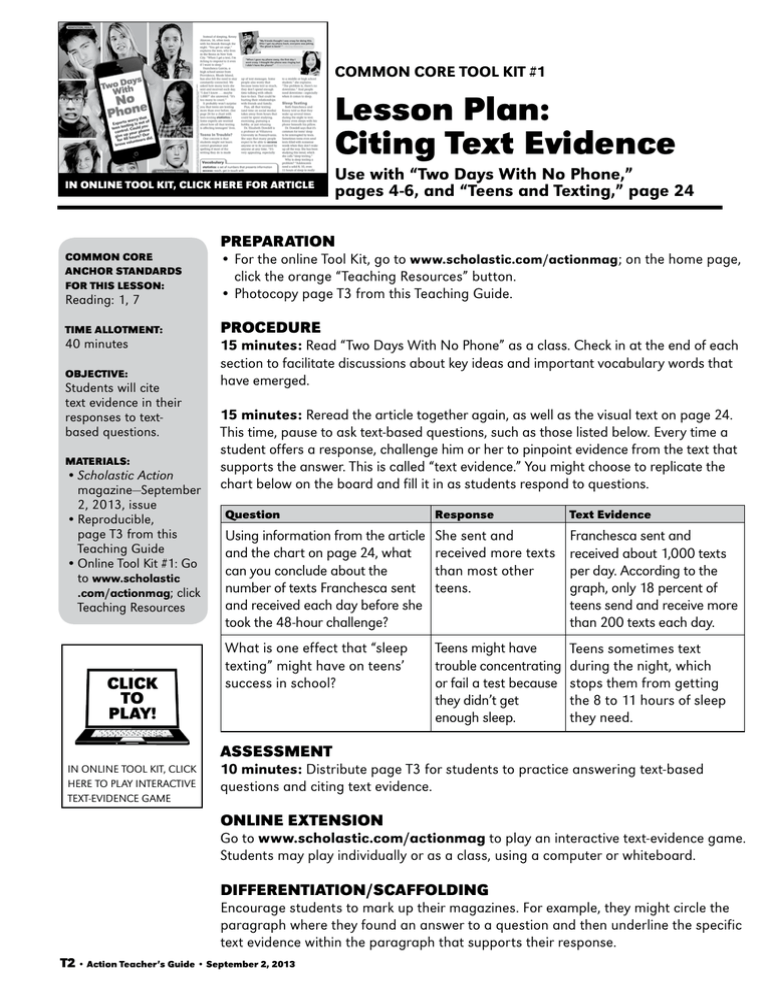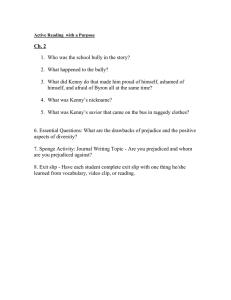Citing Text Evidence Lesson Plan for High School
advertisement

common core tool Kit #1 Lesson Plan: Citing Text Evidence In online tool kit, click here for article Use with “Two Days With No Phone,” pages 4-6, and “Teens and Texting,” page 24 PREPARATION Common core ANCHOR Standards for this lesson: Reading: 1, 7 Time Allotment: 40 minutes objective: Students will cite text evidence in their responses to textbased questions. Materials: •Scholastic Action magazine—September 2, 2013, issue •Reproducible, page T3 from this Teaching Guide •Online Tool Kit #1: Go to www.scholastic .com/actionmag; click Teaching Resources CLICK TO PLAY! • For the online Tool Kit, go to www.scholastic.com/actionmag ; on the home page, click the orange “Teaching Resources” button. • Photocopy page T3 from this Teaching Guide. Procedure 15 minutes: Read “Two Days With No Phone” as a class. Check in at the end of each section to facilitate discussions about key ideas and important vocabulary words that have emerged. 15 minutes: Reread the article together again, as well as the visual text on page 24. This time, pause to ask text-based questions, such as those listed below. Every time a student offers a response, challenge him or her to pinpoint evidence from the text that supports the answer. This is called “text evidence.” You might choose to replicate the chart below on the board and fill it in as students respond to questions. Question Response Text Evidence Using information from the article and the chart on page 24, what can you conclude about the number of texts Franchesca sent and received each day before she took the 48-hour challenge? She sent and received more texts than most other teens. Franchesca sent and received about 1,000 texts per day. According to the graph, only 18 percent of teens send and receive more than 200 texts each day. What is one effect that “sleep texting” might have on teens’ success in school? Teens might have trouble concentrating or fail a test because they didn’t get enough sleep. Teens sometimes text during the night, which stops them from getting the 8 to 11 hours of sleep they need. Assessment IN ONLINE TOOL KIT, CLICK HERE TO PLAY INTERACTIVE TEXT-EVIDENCE GAME 10 minutes: Distribute page T3 for students to practice answering text-based questions and citing text evidence. online extension Go to www.scholastic.com/actionmag to play an interactive text-evidence game. Students may play individually or as a class, using a computer or whiteboard. DIFFERENTIATION/SCAFFOLDING Encourage students to mark up their magazines. For example, they might circle the paragraph where they found an answer to a question and then underline the specific text evidence within the paragraph that supports their response. T2 • Action Teacher’s Guide • September 2, 2013 Name: _______________________________ READING AND WRITING POWER FOR TEENS Cite Your Evidence MAGAZINE spotlight skill: Citing Text Evidence use with: “Two Days With No Phone” (p. 4) and Common Core Tool Kit #1 Read “Two Days With No Phone” on pages 4-6 of this issue of Action magazine. Then answer the questions below. Be sure to use details from the text (text evidence) to support your responses. Question Response Text Evidence 1. What effect might too much texting have on a student’s relationships? ©2013 by Scholastic Inc. Teachers may make copies of this page to distribute to their students. 2. What is “sleep texting”? 3. What does the word adolescents mean in Dr. Dowdell’s quote about sleep needs? 4. Make a prediction about Kenny and Franchesca. Which student is more likely to text less in the future than they did before the experiment? 5. A teen checks his phone every five minutes, and his mood changes when he doesn’t have access to his phone. Might he have an addiction? Action Teacher’s Guide • September 2, 2013 • T3 nonfiction/Health s y a D o w T h t i W No e n o h P that y r r o of ts w Exper xting is out u e o teen t ol. Could y ne contr your pho r p give u hours? Ou id. for 48 lunteers d vo brave Extra Resources Online! •Bonus Quiz •common core Game •3 Reading levels •Listen & Read audio •Lesson plan •Graphic Organizer 4 Scholastic Action | September 2, 2013 www.scholastic.com/actionmag page 4: istockphoto.com (iPhone); Clockwise from Top Left: Tetra images RF/Getty Images; istockphoto.com; blue jean images RF/Getty Images; Tooga/Digital Vision/Getty Images; © Buena Vista Images/Photodisc/Getty Images; Masterfile; Altrendo/Getty Images; Evan Birch/Flickr RF/Getty Images; page 5: © Chris Mott (Boy); © Rachel Brian (Girl) Instead of sleeping, Kenny Alarcon, 16, often texts with his friends through the night. “You get an urge,” explains the teen, who lives in the Bronx in New York City. “When I get a text, I’m itching to respond to it even if I want to sleep.” Franchesca Garcia, a high school senior from Providence, Rhode Island, has also felt the need to stay constantly connected. We asked how many texts she sent and received each day. “I don’t know . . . maybe 1,000?” she answered. “It’s too many to count.” It probably won’t surprise you that teens are texting more than ever before. (See page 24 for a chart with teen-texting statistics.) Some experts are worried about how all that texting is affecting teenagers’ lives. Teens in Trouble? One concern is that students might not learn correct grammar and spelling if most of the writing they do is made “My friends thought I was crazy for doing this. After I got my phone back, everyone was joking, ‘The ghost is back!’ ” —Kenny Alarcon “When I gave my phone away, the first day I went crazy. I thought the phone was ringing but I didn’t have the phone!” —Franchesca Garcia up of text messages. Some people also worry that because teens text so much, they don’t spend enough time talking with others face-to-face. That could be hurting their relationships with friends and family. Plus, all that texting (and time on social media) takes away from hours that could be spent studying, exercising, pursuing a hobby, or just relaxing. Dr. Elizabeth Dowdell is a professor at Villanova University in Pennsylvania. She says that many people expect to be able to access anyone or to be accessed by anyone at any time. “It’s very appealing, especially Vocabulary statistics: a set of numbers that presents information access: reach, get in touch with depressed: feeling very sad for a long period of time isolated: all alone, separated from others addiction: a strong need for something, such as drugs to a middle or high school student,” she explains. “The problem is, there’s no downtime.” And people need downtime—especially when it comes to sleep. Sleep Texting Both Franchesca and Kenny told us that they wake up several times during the night to text. Kenny even sleeps with his phone beneath his pillow. Dr. Dowdell says that it’s common for teens’ sleep to be interrupted by texts. Sometimes teens even send texts filled with nonsense words when they don’t wake up all the way. She has been studying this trend, which she calls “sleep texting.” Why is sleep texting a problem? “Adolescents need a solid 8, 10, even 11 hours of sleep to really function and to think clearly,” reports Dr. Dowdell. If they regularly lose sleep, she adds, teens may start www.scholastic.com/actionmag | September 2, 2013 5 The 48-Hour Challenge According to Dr. Dowdell, teens need to learn that they can—and should— turn off their phones sometimes. So we decided to have Kenny and Franchesca do an experiment. These were the rules: No phone for 48 hours. No computer or Internet either, unless it was for schoolwork. No Twitter, no Instagram. Would these two teenagers be able to do it? “I think I’m going to feel really isolated,” Kenny worried. Franchesca was nervous but brave. “I’m excited for the challenge,” she said. “I don’t know what’s going to happen.” Kenny and Franchesca handed their phones to their mothers for safekeeping. The challenge was on. The Results We caught up with Kenny and Franchesca after 48 phone-free hours. “Wow, it was pure torture,” Kenny joked. But though life with no phone wasn’t easy, he 6 Scholastic Action | September 2, 2013 admitted “it had benefits.” Sure, Kenny missed his friends, and he was sad at times. But he also felt relief Many teens report from the constant texting. troubling problems when “Sometimes it’s teenager they try going without drama, people gossiping,” phones and technology. he explained. “I felt less One recent study asked stressed because I didn’t students to give up phones have to be involved.” and electronic media for Instead of texting, Kenny 24 hours. The result? One went to the gym and in five people experienced caught up on schoolwork. changes in their bodies or The first night, he told us, “I emotions that are signs of slept for 18 hours!” He also possible addiction. Look spent time sitting with his below for some of these family and talking. Kenny’s warning signs. mom helped him with Feeling anxious, homework for the first Thinking lonely, or time in two years. Said you hear your worried Kenny, “I felt closer to phone ring or my parents.” vibrate, even though it is Franchesca had an not there even happier result when she put away her phone. “I loved it!” she said. “I was going to the gym and hanging out with friends and playing basketball. I had a wonderful experience.” She slept better too. Strong Franchesca decided to Nausea, continue the experiment cravings to pick feeling up your phone for a while. “I think I’ll sick and check be so much smarter messages and healthier,” she explained. “Everybody in the world should try it.” Kenny doesn’t plan to give up his phone again. But he Fidgeting, now knows that he can live being unable without it. Said the teen, “It to sit or was a reality check.” stand still —Sarah Jane Brian Signs of Addiction Masterfile having trouble in school. They may become grumpy, angry, or depressed. A lack of sleep can lead to weight gain and even obesity. That’s because many people turn to junk food for quick energy when they are tired.

